________________
210
EPIGRAPHIA INDICA
[VOL. XXVII
lying on the boundary of the village granted, and cites the names of nine (not eight as stated in the grant) out of the 14 donees who received shares in half the portion of the villages which was granted to Brāhmaṇas and who were to act as trustees for that portion. The temple was to be in charge of the Guravas who were to look after the bodily enjoyments of the god and the Brāhmaṇa grantees were to take care of the satra. In addition to these duties, the Brāhmaṇas were to perform daily pañchämrita, waving of lights etc. to the god. After the Marāthi portion the verse describing Mhäidēva, the composer, is repeated. The grant then ends with a benediction in verse and prose.
The details of the date are given thus in 11. 1-2: the Saka year 1172 represented by the words nētra (2), adri (7) and rudra (11), the cyclic year Sadhārana, the month Mägha and the day of Purāri, i.e., the 14th of the dark fortnight. The 14th tithi of the dark fortnight of Magha is the well-known Mahāśivaratri day; but as no week day is given, it is not possible to verify the date. The day on which the 14th tithi of the dark fortnight of a month falls at midnight is reckoned as the Sivaratri day. In the present case the 14th tithi was current at midnight on Monday, the 20th February A.D. 1251 and ended on Tuesday the 21st of February 1251 A.D. at.03 after mean sunrise. It follows, therefore, that the 20th was the date intended.
Of the place names oocurring in this grant Mamjaravātaka or Mamjarabāde is the modern Marjarde, a village nine miles to the north-east of Tasgaon, the headquarters of the taluk of the same name in the Satara District. Gövaru, Välagavāda, Hadhinaura and Pēdha are the modern Gövargaon, Balagavade, Hātnūr and Ped at a distance of 2, 2, 3, 3} miles respectively from the village granted. Suragiri is evidently Dēvagiri or modern Daulatabad. About Parnnakhēta a few words are necessary. Hēmādri in his introduction to the Vratakhanda, a part of the Chaturvargachintamani informs us that Mallugi, a Yadava prince, captured the town Parnakhēta from his enemies with a view to making it his residence. Prof. V. V. Mirashi has opined that this town must be situated somewhere to the east of Khåndēsh, possibly in Berar, and has suggested that it should be identified with Pätkhēd, a village about 4 miles to the south-west of Bārsi-Ţākaļi in Berar. Ordinarily the word Parnakhēta would be transformed into Pāņakhēda, Palakhēda or Pānakhēda, but not to Pätkhēda; for Pāna, Pāla, etc., are the derivatives of
Parna and Pāta, Patta, etc., of patra. I, therefore, think that Prof. Mirashi's identification does • not hold good as far as phonetics is concerned. I venture to suggest an identification of the place.
In the south-west corner of the West Khandesh District is a comparatively big village named Palkhed or Pankheda which may with greater probability be identified with Parnnakhēta.
-
TEXT [Metres : vv. 1, 2, 5-9, 11, 12, 14-24 Sārdülavikridita; 3, 25, 26
Sragdhara; 4 Prithvi ; 10 Giti ; 13 Arya; 27 Salini.)
First Plate
1 ओं ॥ स्वस्ति श्रीमति शाल (लि)वाहनशके नेत्राविरुद्रोन्मि
2
rest(at)etura
(*)
gfafectate
[g]erfeffa
I [ET]
1 Bombay Gazetteer, Vol. I, part ii, p. 271, v. 34. 2 Ahove, Vol. XXI, p. 131, f. n. 1. * From the original plates. • Shown by a symbol.
Read. griefcaret.




